

Horrible Histories The Plague Song. The Black Death. History Channel - The Plague part 13. History Channel - The Plague part 14. History Channel - The Plague part 15. History Channel - The Plague part 16. HowStuffWorks Videos The Black Death The Depopulation of Europe.flv. Horrible Histories Peasents Plauge. Black Plague: The Least You Need to Know. The Black Plague: The Least You Need to Know This page is under construction!

Q: What was it? A: Most scholars think the Black Plague was a bacterial strain of Yersinia pestis. A growing minority of scholars (e.g., Graham Twigg) think we have misdiagnosed the disease, and that it was actually anthrax or some mutation of cattle murrain. It's also possible the Black Plague might not have been a single disease at all, but rather a combination of several at once or a series of different ones over many decades.
Q: Does it have other names? A: Today, it's best known as the Black Death or the bubonic plague. Q: Where did it come from? A: The first historical record of bubonic plague is in Central Asia in 1338/39. Q: How it is transmitted? A: Fleabite transmits common plague bacteria. Impact of the Black Death - The Global Impact of the Black Death. Updated March 23, 2014 The Black Death was one of the worst pandemics in human history.

In the 14th century, at least 75 million people on three continents perished due to the painful, highly contagious disease. Originating from fleas on rodents in China, the “Great Pestilence” spread westward and spared few regions. In Europe’s cities, hundreds died daily and their bodies were usually thrown into mass graves. Guy de Chauliac. Guy de Chauliac Guy de Chauliac, also called Guido or Guigo de Cauliaco (ca. 1300 – 25 July 1368) was a French physician and surgeon who wrote a lengthy and influential treatise on surgery in Latin, titled Chirurgia Magna.
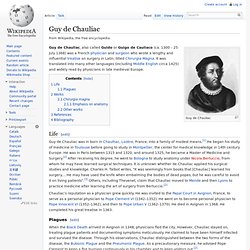
It was translated into many other languages (including Middle English circa 1425) and widely read by physicians in late medieval Europe. Life[edit] Guy de Chauliac was in born in Chaulhac, Lozère, France, into a family of modest means.[1] He began his study of medicine in Toulouse before going to study in Montpellier, the center for medical knowledge in 14th century Europe. He was in Paris between 1315 and 1320, and around 1325, he became a Master of Medicine and Surgery.[2] After receiving his degree, he went to Bologna to study anatomy under Nicola Bertuccio, from whom he may have learned surgical techniques.
Chauliac's reputation as a physician grew quickly. Plagues[edit] Works[edit] Chirurgia magna[edit] Emphasis on anatomy[edit] Other works[edit] Plague4. Undefined.
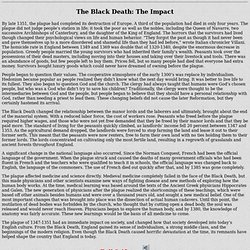
Salem Press. Consequences of the Black Death. Illustration of the Black Death from the Toggenburg Bible (1411) The consequences of the Black Death included a series of religious, social and economic upheavals, which had profound effects on the course of European history.
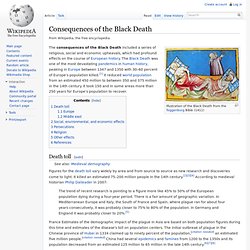
The Black Death was one of the most devastating pandemics in human history, peaking in Europe between 1347 and 1350 with 30–60 percent of Europe's population killed.[1] It reduced world population from an estimated 450 million to between 350 and 375 million in the 14th century. It took 150 and in some areas more than 250 years for Europe's population to recover.
Death toll[edit] Figures for the death toll vary widely by area and from source to source as new research and discoveries come to light. The trend of recent research is pointing to a figure more like 45% to 50% of the European population dying during a four-year period. Europe[edit] In Italy, Florence's population was reduced from 110,000 or 120,000 inhabitants in 1338 to 50,000 in 1351. Middle east[edit] Black Death in medieval culture. Inspired by Black Death, The Dance of Death is an allegory on the universality of death and a common painting motif in late medieval period.
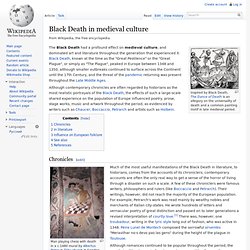
The Black Death had a profound effect on medieval culture, and dominated art and literature throughout the generation that experienced it. Black Death, known at the time as the "Great Pestilence" or the "Great Plague", or simply as "The Plague", peaked in Europe between 1348 and 1350, although smaller outbreaks continued to surface across the Continent until the 17th Century, and the threat of the pandemic returning was present throughout the Late Middle Ages.
Although contemporary chronicles are often regarded by historians as the most realistic portrayals of the Black Death, the effects of such a large-scale shared experience on the population of Europe influenced poetry, prose, stage works, music and artwork throughout the period, as evidenced by writers such as Chaucer, Boccaccio, Petrarch and artists such as Holbein.
Chronicles[edit] Alas! Effects of the Black Death" The Black Death reared its head sporadically in Europe over the next few centuries.
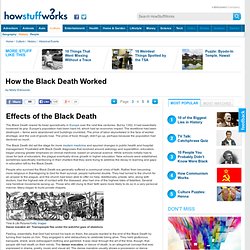
But by 1352, it had essentially loosened its grip. Europe's population had been hard hit, which had an economic impact. The workforce had been destroyed -- farms were abandoned and buildings crumbled. How the Black Death Changed the World. Each Monday, this column turns a page in history to explore the discoveries, events and people that continue to affect the history being made today.

Seven thousand people died per day in Cairo. Three-quarters of Florence's residents were buried in makeshift graves in just one macabre year. One third of China evaporated before the rest of the world knew what was coming. By the time the tornado-like destruction of the 14th-century bubonic plague finally dissipated, nearly half the people in each of the regions it touched had succumbed to a gruesome, painful death. The Black Death – as it is commonly called – especially ravaged Europe, which was halfway through a century already marked by war, famine and scandal in the church, which had moved its headquarters from Rome to Avignon, France, to escape infighting among the cardinals. In the end, some 75 million people succumbed, it is estimated. Quick killer The disease existed in two varieties, one contracted by insect bite and another airborne. KS3 Bitesize History - The Black Death : Revision.
Black Death ("Hollaback Girl" by Gwen Stefani) Horrible Histories the plauge report. History - British History in depth: Black Death: The lasting impact.